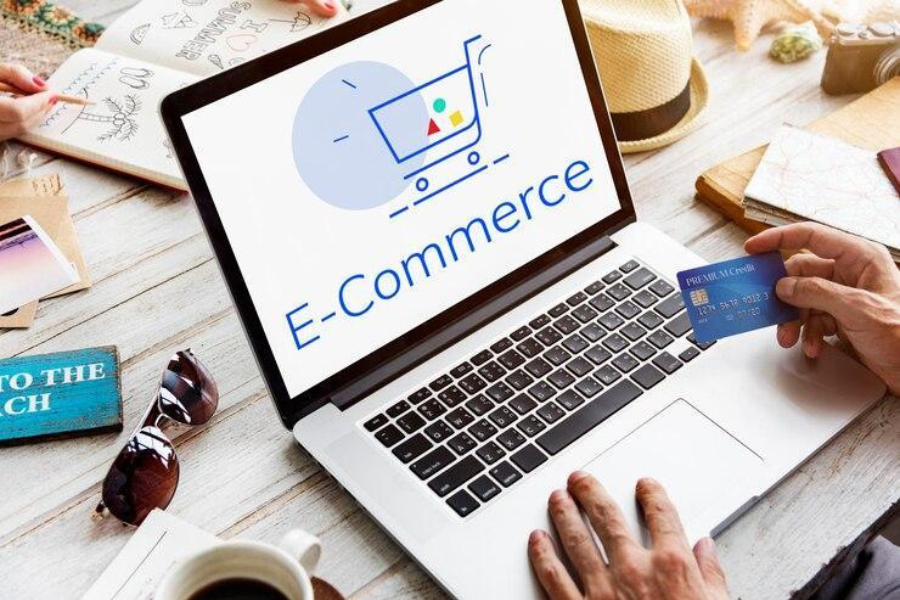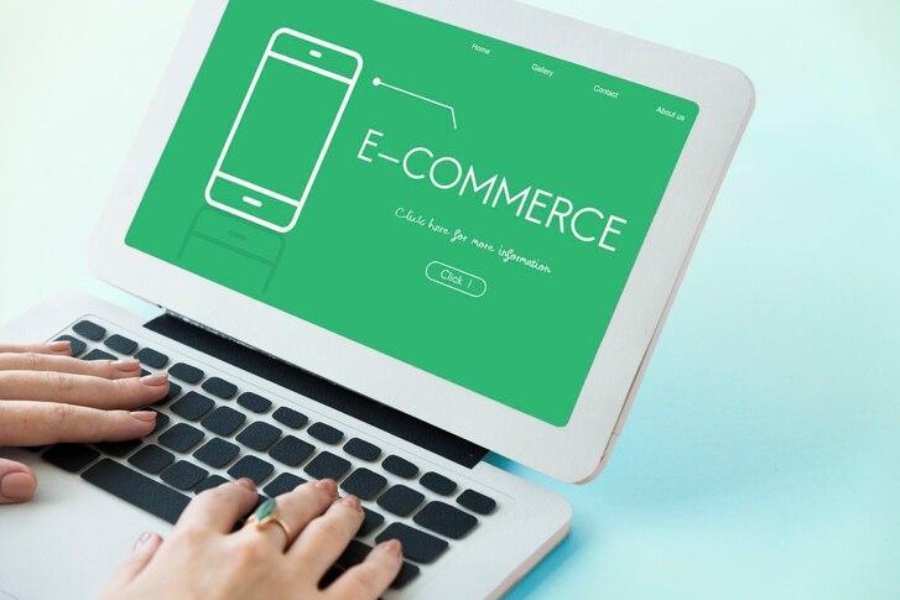The ecommerce business model comes in different types. Unlike traditional brick-and-mortar stores, there are different types of ecommerce business models. All of these are things you should know before you decide on one. In this article, we present to you six of them and how to choose the type that best suits your unique business needs.

Source: Freepik
What Ecommerce Models Are There

Source: Freepik
Knowing the existing e-commerce models is a key step to succeeding as an online store owner. When you are ready to launch your store based on your model, NEXT BASKET can help you set up a thriving online store to fetch you great returns. Below are the most common types of ecommerce models.
- Business-to-consumer (B2C)
- Business-to-business (B2B)
- Consumer-to-consumer (C2C)
- Consumer-to-business (C2B)
- Business-to-administration (B2A)
- Consumer-to-administration (C2A)
We’ll look at each one of them in turn.
Business-To-Consumer (B2C)

Source: Freepik
Business-to-consumer (B2C) involves selling products and services directly to the consumer or end user. In a B2C ecommerce business model, the seller usually buys from a third-party supplier to resell to the end customer.
This type of ecommerce business model enables you as a seller to source goods in bulk at a lower price. Then, you resell them at a higher price (adding your own profit) to the public or direct consumers.
Business-To-Business (B2B)
Business-to-business (B2B) e-commerce involves the sale of goods and services between businesses. When one business sells its product or service to another business in bulk, it is simply known as a B2B model.
It is common to find manufacturers or big wholesalers operating this type of electronic commerce. This means that the buyers within a B2B ecommerce model can resell to consumers.
The difference between B2C vs B2B ecommerce is that the former targets single customers. Meanwhile, the latter focuses on other businesses and bulk orders.
Consumer-To-Consumer (C2C)
The consumer-to-consumer (C2C) ecommerce business model is when a customer sells their own goods or services directly to another consumer.
This could be done through a third-party platform known as an online marketplace that charges transaction or listing fees. Examples of C2C e-commerce include Etsy and Konga, where people can send their old personal belongings to other consumers. They can do this without being a registered business.
Consumer-To-Business (C2B)
The consumer-to-business (C2B) e-commerce model refers to a consumer selling to a company on a website.
This website serves as the platform where individuals can sell goods and services to companies interested in buying them. It promotes rivalry and a favorable pricing strategy for consumers.
Business-To-Administration (B2A)
The B2A model is also known as the business-to-government (B2G) ecommerce model. This is because it involves transactions between companies and public administration.
The B2A ecommerce transactions typically involve government groups, especially in industries like defense, healthcare, or infrastructure. Some specialized platforms or portals cater to the unique needs of public sector sourcing and control.
Consumer-To-Administration (C2A)
The Consumer-to-Administration model is one where individuals (consumers) engage in a deal with government or administrative groups. In essence, C2A represents the relationship between individual consumers and public sector organizations or government agencies.
In Nigeria, the Consumer-to-Administration (C2A) business model is becoming more popular. The government and other organizations use digital tech to offer services and engage with citizens.
For example, the Federal Inland Revenue Service (FIRS) online portal for tax-related transactions is C2A. Also, the National Identification Number (NIN) registration by the National Identity Management Commission (NIMC) is C2A.
Key Factors Influencing Ecommerce Model Choice
Choosing the right ecommerce model is necessary, as each has different goals and needs it can satisfy. Let’s see some of the most important factors that decide the model you opt for.
After considering these actors listed below, conduct an ecommerce business model comparison. These will help you find the most profitable and matching model for your business.
Aligning Business Goals With Ecommerce Models
Your business goals and the target market should guide you when picking an e-commerce model. As an example, if you wanted to supply toiletries and daily needs to families across Nigeria, the B2C (Business-to-Consumer) model is more appropriate.
However, if you plan to supply to supermarkets and shops, then you need to pick the B2B (Business-to-Business) model.
Meanwhile, if you were to start a marketplace ecommerce platform where people can sell their belongings or handmade items, the C2C model works best. A popular example of C2C commerce is Etsy.
Lastly, if you want to start a platform like Upwork, where individuals offer their services to companies, use the C2B model. Real-life examples are Jumia in Nigeria and Alibaba, which use B2C and B2B models, respectively.
Assessing Target Market and Customer Needs
Your target customers play a huge role in determining your ecommerce business model. For instance, individual buyers are looking for a smooth shopping experience. They want their goods fast without having to bother about supply chain details.
With a B2B model, customers are more involved and want to know how supply can be easier for them. They also want more detailed product info and quality images to make decisions. You can also offer advice on how to navigate the business to see more success in your business, too.
Knowing your audience is key to finding out what they would expect from you. Namely, YummyBox in Nigeria uses the subscription box ecommerce model. They target individual customers who want yummy goodies without having to leave their homes in search of them.
Evaluating Product or Service Suitability
The kind of product you want to sell also plays a big role. If you were selling physical products using the B2B model, you would handle bigger stocks and need to find ways for the goods to reach customers safely.
Meanwhile, the B2C mode depends on your customers. You may have a large number of customers or some that want bulk but not reselling. Therefore, you need proper inventory management and swift logistics.
On the other hand, if you are dealing with digital products or services, your platform should be responsive and instant. The B2C model would involve direct downloads, while the B2B model would include subscription services or enterprise solutions.
On a side note, a platform like NEXT BASKET can help a new online store that has a lot of stock to manage. However, the dropshipping business model works for anyone who doesn’t like to manage inventory.
Considering Scalability and Growth Potential
Scalability covers how your chosen ecommerce platform can expand to fit your new demands. Think of how a balloon expands as you pour more air into it. In the case of the B2C model, it could be adding more products, gaining more traffic, and having to handle more orders.
Meanwhile, for the B2B model, you need a larger-scale ecommerce solution that can handle bulk orders and complex transactions.
Step-By-Step Guide To Choosing the Right Type of Ecommerce Model for Your Business

Source: Freepik
We keep stressing the importance of picking the right model because it shapes your journey. Before an ecommerce business model selection, you should check out the following steps:
- Define Your Products or Services: Clearly define what you are selling. Are you offering physical products, digital goods, services, or a combination? The nature of your offerings can influence the choice of ecommerce model.
- Identify Your Target Audience: Understand your target audience. Are you selling to consumers (B2C), other businesses (B2B), or both? Knowing your audience helps tailor the ecommerce model to their preferences and needs.
- Consider Your Business Size and Resources: Evaluate the size of your business and the resources available. Some ecommerce models may require big investments in technology, logistics, or marketing. Consider what you can manage.
- Understand Your Primary and Secondary Model: Decide your primary focus. Is it selling directly to consumers or other businesses? Or would you engage in both models with the former as the primary model and the latter as your secondary?
- Decide on the Ecommerce Platform: Select an ecommerce platform that aligns with your business needs. Factors to consider include ease of use, scalability, features, and linking capabilities.
NEXT BASKET is the perfect option for you when starting your e-commerce business. This ecommerce platform comes with wide features and integrations. Besides these, it also offers 125 ecommerce and marketing services executed by experts that can make online selling easy for you. Your choice of business model doesn’t matter.

These steps can help you make informed decisions about the most suitable ecommerce model for your business, aligning it with your goals, resources, and target market.
Tips for Customizing Your Ecommerce Model To Fit Your Unique Business Needs

Source: Freepik
Customizing your ecommerce model to fit your unique business needs is key for optimizing operations. It’s also crucial for meeting customer expectations and achieving long-term success.
Main Tips
Below are detailed tips to guide you through the custom process.
- Understand Your Business Requirements: Conduct a thorough analysis of your business requirements. Identify key aspects such as the nature of your goods, target audience, sales volume, and specific challenges in your industry.
- Define Your Unique Selling Proposition (USP): Clearly articulate your USP and how it sets you apart from competitors. Align your ecommerce model with your USP to attract customers with a compelling value.
- Choose a Flexible Ecommerce Platform: Your ecommerce platform should offer flexibility and scalability. It should also allow for easy customization and integration with third-party tools for your rising business needs.
- Tailor the User Experience (UX): Customize the user interface and overall user experience to reflect your brand identity. Also, it should cater to the interests of your target audience. This includes designing an appealing website, intuitive navigation, and a smooth checkout process.
- Personalization for Customers: Implement personalized features to enhance the customer experience. This could involve personal product advice, dynamic content based on user behavior, or a targeted marketing campaign.
- Adapt Payment and Pricing Models: Customize your payment and pricing models to align with your business strategy. Offer multiple payment options to fit customer likes and consider dynamic pricing strategies if applicable.
- Custom Product Catalog: Create a custom product catalog that shows your offerings in a way that resonates with your target audience. Consider grouping products, creating product bundles, or pushing specific collections based on interests.
Customizing your ecommerce model is an ongoing process that requires a deep knowledge of your business. What’s more, you should know your customers and the dynamic nature of the ecommerce landscape.

Source: Freepik
Extra Tips
Customization could be seamless for some people and trickier for others. It all depends on your level of tech knowledge, so find more tips below:
- Implement Custom Search and Navigation: Improve your website’s search functionality and direction. Implement custom search filters and sorting options to help customers quickly find what they’re looking for.
- Integrate with Third-Party Tools: Customize your ecommerce model by integrating with third-party tools that align with your business needs. This could include CRM systems, marketing automation platforms, and analytics solutions.
- Mobile Optimization: Since there is a rise in mobile devices for online shopping, ensure that your ecommerce model is responsive. Also, make the mobile experience to be user-friendly, responsive, and efficient.
- Flexible Shipping and Fulfillment Options: Design the shipping and fulfillment processes based on your product features and expectations. Offer flexible shipping options and clear communication about delivery times.
- Implement Multi-Channel Selling: If you sell through various channels, customize your ecommerce model to run multi-channel selling. Ensure smooth integration and consistency across all channels.
- Custom Reporting and Analytics: Implement custom reporting and analytics tools to gain insights into your business performance. Customize dashboards to track key metrics, customer behavior, and sales trends specific to your business goals.
- Compliance and Security: To protect your customer information, you must adhere to legal and security requirements. Ensure you follow data protection regulations and secure payment processing.
- Regular Review and Update: Continuously monitor your ecommerce model’s performance and customer feedback. Regularly check and update your customization strategies to adapt to market changes.
All of these are important to stay competitive and responsive to changing business needs. Good luck!
Potential Challenges To Watch Out for When Implementing Your Chosen Ecommerce Model

Source: Freepik
Implementing an ecommerce model comes with its set of challenges. Being aware of them and planning well can help you navigate the implementation process more effectively.
After identifying the problems, perform an ecommerce business model analysis to learn the cause and fix the problems. Below are potential challenges to watch out for.
Tech Challenges
Platform Compatibility: Integrating your chosen ecommerce platform with current systems or third-party tools may pose issues. Ensure that the technology stack is cohesive and can work seamlessly together.
Scalability: Also, if your business experiences rapid growth, ensuring that your ecommerce framework can scale is important.
Security Concerns: Using strong security measures to protect customer data, payment information, and sensitive business data is vital. Security breaches can harm your reputation and lead to legal consequences.
User Experience Issues
Navigation and Design: Poor website direction and design can result in a subpar user experience, especially B2C. Ensure that your website is intuitive, responsive, and appealing to boost customer satisfaction.
Mobile Responsiveness: With the increasing use of mobile devices, a lack of mobile speed can lead to lost opportunities. Optimize your website for mobile users to provide a smooth experience across devices.
Payment and Checkout Challenges
Payment Gateway Issues: Compatibility issues with payment gateways or transaction failures can also lead to big sales losses. Regularly test and update your payment processing system to prevent disruptions.
Cart Abandonment: High rates of cart abandonment can occur due to a complex or lengthy checkout process. Unify the checkout process and offer multiple payment options to reduce abandonment rates.
Logistical and Fulfillment Problems
Inventory Management: Not tracking inventory levels can lead to sell-outs with no backup. Use strong inventory management systems to ensure real-time tracking and synchronization.
Shipping and Delivery: Delays or mishandling in shipping can result in customer dissatisfaction. Work with reliable logistics partners and give customers accurate shipping info.
Marketing and Visibility Challenges
Customer Acquisition: Attracting and retaining customers in a competitive online market can be tough. Develop effective digital marketing strategies to drive traffic and promote your products or services.
SEO Optimization: Poor search engine optimization (SEO) can affect your website’s visibility. Optimize your website for search engines to improve rankings and increase organic traffic.
Customer Service and Communication
Communication Gaps: Poor communication inquiries can harm your sales. B2B customers need more details compared to B2C, which uses effective customer support systems to address queries and concerns promptly.
Product Information: Insufficient product information on your website can lead to confusion and dissatisfaction. Ensure that product descriptions, images, and specifications are comprehensive and accurate.
Data Management and Analytics
Data Accuracy: Relying on inaccurate or outdated data for decision-making can lead to poor choices. Implement strong analytics tools and regularly audit your data.
Interpreting Data: Understanding and applying the data generated by your ecommerce model can be tough. Invest in analytics skills or work with professionals to extract meaningful insights from your data.
By preparing ahead and addressing these potential challenges of your chosen model, you can actively manage them. This could be done by using the right tools and knowing customers’ expectations fully.
Frequently Asked Questions
What is ecommerce?
Ecommerce refers to electronic commerce, which involves the buying and selling of goods and services on the Internet.
What is a direct-to-consumer business?
This ecommerce business model has to do with selling directly to consumers with no third parties such as wholesalers or online retailers involved. There is no middleman involved in this ecommerce model.
What are the six types of ecommerce?
The six basic ecommerce models that exist are Business-to-Business (B2B), Business-to-Consumer (B2C), Consumer-to-Consumer (C2C), Consumer-to-Business (C2B), Business-to-Administration (B2A), and Consumer-to-Administration (C2A).
How can I transition from one ecommerce model to another without disrupting my business operations?
Transitioning between models doesn’t need to halt your business operations if you plan it well. You need to first identify the reason for the shift. It could be that your current ecommerce business model profitability isn’t as fruitful as you expected.
If you are moving from a traditional B2C to a marketplace e-commerce platform, you can set up the new place while still running your old store. This way, the migration won’t affect your operations. After adjusting to the new platform, you can create awareness about the added advantage of shopping from you.